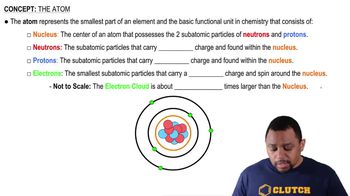Which statements completed with a to e will be true and which will be false?
An atom of N compared to an atom of Li has a larger (greater)
c. number of protons
 Verified step by step guidance
Verified step by step guidance Verified video answer for a similar problem:
Verified video answer for a similar problem:



 1:25m
1:25mMaster Subatomic Particles (Simplified) Concept 1 with a bite sized video explanation from Jules
Start learning